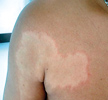Awareness key to controlling leprosy
Leprosy is an ancient disease which carries a substantial degree of social stigma even now. For centuries, leprosy was thought to be a hereditary disease, a curse, or a punishment from God. Now it is established that leprosy is a contagious disease caused by the slow growing bacterium, Mycobacterium leprae.
History of leprosy in Sri Lanka
In Sri Lanka, important milestones in the management of leprosy commenced with the segregation of patients in 1701. In 1708, the first Leprosy Hospital was established in Hendala. The Lepers’ Ordinance was introduced in 1901 mandating segregation. Dapsone monotherapy was started in the 1940s and the Anti Leprosy Campaign was established in 1954. In 1983 Multi Drug Therapy was initiated island-wide.
 Single hypo pigmented patches |
 Ear changes |
 Thickened peripheral nerves |
 Multiple hypo pigmented patches |
A social marketing campaign to reduce stigma associated with leprosy began in 1989. And with this intervention, Sri Lanka reached disease elimination targets in 1995. However, the situation of leprosy has changed as shown by the current statistics of the disease
Current situation of leprosy in Sri Lanka
In 2012 there were 2,211 registered cases and among them 2189 were new cases and 163 were child cases. 1089 were infectious (transmissible to others).
There is a recent increase in the number of new cases of leprosy and most of the patients were infectious. Hence it is important for the public to have knowledge and information of the disease so that they can seek treatment early before permanent disability due to complications of the disease occurs.
Leprosy is a chronic infection of the skin and nerves. Its most probable route of infection is by respiratory droplets. Leprosy has a very low infectiousness and does not usually spread by close contact through intact skin. This disease can manifest a long period after infection with the bacterium due to the very slow multiplication of the bacterium inside the human body, and it may take up to 5-10 years for lesions to develop. Most of the disability resulting from leprosy is due to the damage caused to nerves. Neuropathy can be prevented and reversed if the disease is detected early.
Leprosy is diagnosed by finding at least one of the following cardinal signs.
- Definite loss of sensation in a hypo-pigmented or reddish skin patch
- A thickened or enlarged peripheral nerve, with loss of sensation and/ or weakness of the muscles supplied by the nerve
- The presence of Mycobacterium leprae bacteria in a slit skin smear test
There are two main types of leprosy, termed paucibacillary (non infectious type containing few bacteria) and Multi-bacillary (infectious type with large numbers of bacteria in the lesions). Hypo-pigmented anaesthetic patches, plaques and nodules, thickened peripheral nerves, nerve palsy and non healing ulcers are the usual manifestations of leprosy.
Leprosy commonly presents as non-sensitive hypo pigmented skin patches. These patches can be single or multiple. These patches are copper coloured. They are dry and have less hair over the skin patch. There is reduced or loss of sensation in these lesions. There may be thickened nerves in the vicinity.
At times there can be multiple hypo-pigmented patches. Those are usually on the trunk. These may be symmetrical. Usually there is associated peripheral nerve involvement, and all lesions may not necessarily have sensory impairment.
Unfortunately, patients who are detected late will end up having irreversible loss of nerve function. Due to that there can be loss of sensation of regions of the skin and loss of function of muscles. Sensory loss of the skin can lead to recurrent injuries to skin which can lead to non-healing ulcers. Loss of function of the muscles can lead to paralysis and deformities of body.
Treatment of leprosy
Treatment of leprosy depends on the type of leprosy described above. The duration of treatment varies between 24 to 48 weeks. All drugs used in the treatment of leprosy are supplied free of charge from government hospitals and are available at skin clinics. They come in patient friendly blister packs, colour coded for adults and children. Leprosy treatment is safe even during pregnancy and breast feeding.
Generally, advanced nervous dysfunction cannot be reversed. Therefore these patients need treatment and adaptations to prevent further damage due to nerve dysfunction.
Rehabilitation also plays a major role in the management of patients who already have a disability due to leprosy. It is important to understand that Leprosy is a curable disease without any residual defects, if detected and treated early. The most important factor to prevent disability is by early detection and completing the schedule of treatment as prescribed. For early detection of leprosy, public awareness regarding the disease and elimination of social stigma associated with leprosy is essential. All who have suspicious skin patches and nerve related symptoms should go to a Skin Clinic in any hospital in Sri Lanka. This will improve early detection and treatment and prevent disability.
Dr. Anjalee Hettiarachchi is a Research Assistant and Prof. Jennifer Perera is Chairperson, Communicable Diseases Committee of the Sri Lanka Medical Association
Follow @timesonlinelk
comments powered by Disqus


